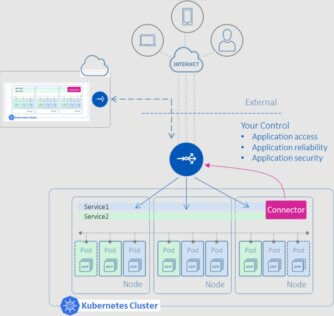By: Amr Alashaal, Regional Vice President, Middle East at A10 Networks

For digital business, transformation, and resiliency, success depends on application performance. Organisations must deliver the best possible experiences for employees and customers while driving innovation and ensuring security. To meet these interrelated objectives, many enterprises are migrating application delivery to hybrid/multi-cloud environments and related techniques to achieve the kind of agility and resiliency formerly only found in public cloud providers.
In a recent survey, The State of Cloud Application Delivery, A10 Networks and Gatepoint Research asked senior technology decision-makers about their experiences delivering applications in the cloud, and what today’s organisations need to achieve the digital resiliency on which their businesses depend.
Given the critical role of application delivery performance in digital business success, the fact that only 34 percent of companies are highly satisfied with their application delivery controller (ADC) solution should raise eyebrows.
Modern Business runs on Hybrid Cloud and Multi-cloud Application Delivery

It’s important to state the key role of application reliability and performance for today’s organisations. To compete effectively and grow in modern digital markets, businesses must meet high customer expectations for a great experience. Hybrid workplace strategies and work-from-home policies make it all the more critical to deliver a consistent high-quality experience wherever people work. Rising cyberthreats and an expanding attack surface call for a heightened focus on security. And agility is a must to support innovation and keep pace with fast-moving markets.
To address these needs, organisations increasingly host their applications in hybrid cloud and multi-cloud environments. According to the survey, while most respondents continue to host applications on-premises, 85 percent use public cloud platforms—usually more than one—and 43 percent use private clouds.
This approach offers several potential benefits. A more diverse application infrastructure allows greater flexibility to host each application on the optimal platform, in the optimal location, to ensure availability and responsiveness. By tapping into scalable resources on-demand, companies can adapt more quickly to changing business needs and IT strategies and shifting customer demand. Moving to more economical and flexible licensing and pay-as-you-go models can free up funds for innovation. And with the right tools, organisations can achieve better visibility into end-to-end application security and performance than they could in a traditional on-premises data centre.
Nonetheless, as seen in the low rate of satisfaction reported in the survey, many organisations are hampered by application delivery technologies that fail to meet their requirements.
How Underperforming ADCs Undermine the Promise of the Cloud
Ensuring application delivery performance in a hybrid cloud and multi-cloud environment hinges on several key ADC functions. Global server load balancing (GSLB) is essential, as organisations need to go beyond traditional disaster recovery requirements to optimise traffic and ensure availability across multiple data centres and clouds. With the vast majority of internet traffic now encrypted, TLS/SSL offload makes it possible to perform TLS/SSL encryption and decryption without straining server resources or creating bottlenecks. Application acceleration and optimisation capabilities, including application analytics, fast root-cause analysis, and performance feedback for developers, are invaluable for delivering an outstanding, and consistent, customer experience while keeping employees fully productive and engaged.
However, application delivery solutions currently in place often fall short of these requirements. Fully half of survey respondents reported ongoing struggles with legacy application delivery technology. Nearly a third face challenges addressing application security threats. Over one in four experience application downtime and slow performance, and more than 20 percent face visibility and reporting challenges. To overcome these challenges and realise the full business benefits of their hybrid and multi-cloud strategy, these organisations will need to modernise their application delivery infrastructure.
The Agenda for Hybrid Cloud and Multi-cloud App Delivery
The gap between outdated application delivery solutions and modern requirements only continues to grow. With hybrid cloud and multi-cloud complexity rising, organisations need to be able to deploy and deliver applications more flexibly and efficiently, avoid being bogged down in manual tasks, and gain greater insight to ensure that fast-changing environments maintain performance and availability. These needs are reflected in the key objectives for the coming year cited by survey respondents. Forty-eight percent reported plans to increase agility with software/scale-out solutions for a faster response to shifting needs, while 47 percent intend to drive operational efficiency through the deployment of hybrid cloud automation, management, and analytics capabilities.
Survey respondents understood that modernising the ADC will be essential to achieving these goals. Asked about the most important capabilities to ensure successful business objectives, 69 percent named faster troubleshooting and root-cause analysis, which depend on centralised management, analytics, and reporting to better understand their environment and its performance. More than half cited automation as a need to overcome challenges in IT skills development in a fast-changing technology environment, and a similar number saw a need for data analytics and application insights to guide performance optimisation, troubleshooting, security, and more.
Ensuring Digital Resiliency for Better Business Performance
As companies evaluate their existing ADCs and consider future investments, their priorities are closely tied to bottom-line performance. To maximise ROI, they will need to be able to both increase revenue and control expenses. On the revenue side, better application performance will help them deliver outstanding experiences to win and retain customers in competitive markets, as well as keep their workforce engaged, productive, and satisfied.
A modern application delivery approach is clearly needed to help organisations right-size investments by enabling more efficient management, reducing calls to customer support, averting costly and disruptive security breaches, providing agile software options, and leveraging new advanced observability.





